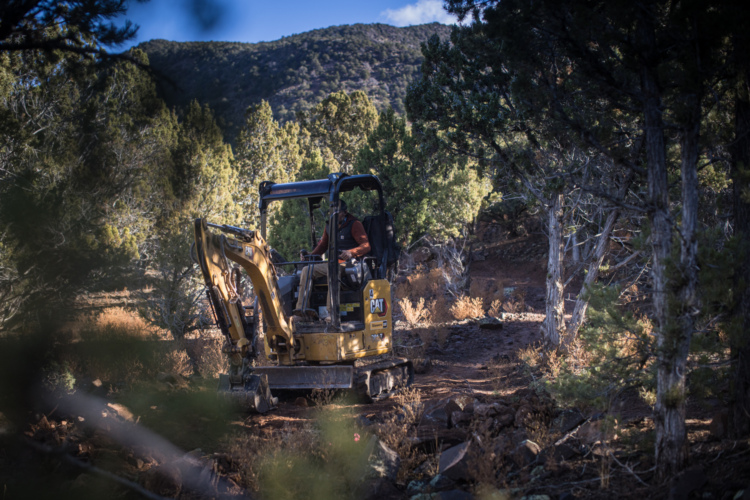
Dropping nearly five figures on a mountain bike isn’t outside the realm of possibilities. Visit most any trailhead and you’ll see plenty of bikes above that mark. Adding frame protection, cleaning the drivetrain, and lubing the chain after every ride are great ways to care for a mountain bike. Regardless of whether you should spend that much money on a mountain bike, one thing is clear: your mountain bike is an investment worth caring for.
Talking shocks with Specter Suspension
Suspension is one of the most costly components on a mountain bike, and it arguably gets the most wear and tear. Some riders stretch their service intervals or ignore them completely.
Of course, this not only damages the suspension but also makes the bike ride terribly as well. Trevor Elson of Specter Suspension sees it all too often.
“You’d be surprised how many problems stem from poor suspension performance,” Elson said, “Service the suspension, and many creaks and cracks go away.”
Elson spent years working in bike shops, where he specialized in suspension. After recognizing a need for local suspension technicians, Elson started Specter.
“Many shops don’t have a guy on hand that does suspension,” noting that often, forks and shocks have to be sent to RockShox or Fox, which can have very long lead times.
Shops in the area started outsourcing their complete suspension service jobs to Elson. He also works with customers on an individual basis as well as sponsored and professional athletes. With Elson’s expertise, we connected with him to learn a handful of maintenance tips for mountain bike suspension to make it last.

Don’t: Neglect your suspension service intervals
“A lot of people just ride their suspension until it is broken,” Elson said. “Then they get service, then they complain about cost.”
Elson compared servicing suspension to regular car maintenance, like changing the oil every 3,000 miles. Mountain bike suspension also has manufacturer-recommended service intervals and they should be followed as closely as possible.
Do: If you can, service forks and shocks early
Fox recommends 125 hours between suspension services. RockShox recommends servicing your mountain bike suspension every 200 hours. Elson recommends not waiting until you hit the recommended hours for your next service. Do it hours before.
“People think 125 hours can be the whole summer,” Elson said. “Most Fox shocks I see make it about 75 hours.” And while RockShox intervals are longer, Elson doesn’t recommend taking them to their recommended 200 hours either.
Also, the type of terrain you regularly ride can make a big difference on the recommended service interval. More frequent service might be necessary if you’re regularly riding at the bike park or through dusty terrain.
If your suspension does need service, you might be experience some of the symptoms in this article.

Don’t: use a pressure washer to clean your bike
Elson sees this all too often. Car washes with the pressure washing wand area common culprit. Even from a distance, that much pressure blows water past the seals.
“You could be destroying the seals, and you’re just pushing more dirt down past the seals,” Elson said. “Everything on the inside is aluminum, which becomes corroded by water if dirt scratches it.”
Elson recommends wiping off dirt and dust after rides with a microfiber cloth and a noncorrosive suspension cleaner, which several brands make.
Do: Use the proper fluids to service your mountain bike suspension
Sitting alongside dry and wet chain lubes in many bike shops is a similar-looking product but for cleaning and lubricating suspension. The oily substance is applied to the stanchions and cycled through the suspension, pulling dirt and grime out. At least, that is the claim.
“They’re a placebo,” Elson said about these products. Elson explained that the seals that are good at not letting too much dirt get into your suspension also don’t let things out.
“That’s why people do the zip tie trick,” Elson said. “They put a zip tie through the wiper to get lube in there.” Elson warns doing this doesn’t have a significant impact and could damage the dust wipers. Taking the suspension apart is the only way to properly clean and lubricate.
If you are doing a suspension service yourself, don’t use motor oil in place of recommended bike suspension oil. You would think that is obvious, but Elson has seen it.
“People will dig way down the rabbit hole and find a motor oil with a viscosity index that is the same,” Elson said. “But it’s not. It’s not lubricating your fork the same…your fork isn’t reaching a high enough temperature.”
Suspension oils however are fairly ubiquitous, but it’s still best to stick with your recommended brand. For example, perhaps a suspension manufacturer recommended a 5wt oil at one point, but now they are calling for a 10wt. Using the 5wt suspension oil you have is usually fine, especially if your other option is motor oil.

Don’t: forget to track your service intervals
For many of us, getting out on the trails is an opportunity to disconnect from our devices, including tracking apps like Strava. While this may be great for your mental health, it could be disastrous for your suspension.
Recommended mountain bike suspension service intervals often come as ridden hours on the suspension. Many of us are keeping track of this by rough estimates at best. If you could care less about recording and sharing your rides on social media, boasting about your new PR, it’s a good idea to use an app like Strava to track how many hours you’ve ridden since your last service.
Do: understand what a suspension service consists of
The phrase “suspension service” gets thrown out a lot, and people can have a different understanding of what their bike shop is doing. Quite often, an advertised “suspension service” is just a replacement of dust wipers and oil, whereas a full service might consist of a damper inspection and cleaning, and checking the condition of the bushings. For full rebuilds on air shocks, it can often require specialty tools, and recharging the internal floating piston with nitrogen.
Some bike shops are limited by know-how, tools, and time in their suspension capability, said Elson. Time is crucial, and the trade may not be worth it for many shops. “Servicing a shock can take an hour,” Elson explained, “and in that same hour, you can do an entire tune-up on a bike.” Simply put, shops need their employee to spend that hour on an entire bike, not a shock or fork.
Try taking your bike to a suspension technician, like Elson, for your next suspension service.
Don’t: be afraid to try servicing your own suspension
As mentioned, opening up your suspension is the only way to clean out dirt and grime. Elson encourages people to do some of the simpler parts themselves, leaving complete services and rebuilds for technicians like him. “You’re going to make a bit of a mess at first, but you’ll get the hang of it,” Elson said.

Do: consider servicing brand new suspension too
“Your newest fork you’re buying in 2023 was assembled last year. It sat in a box on a container traveling the world. It then sat in somebody’s warehouse, sideways, where the oil settles,” Elson explained.
Also, manufacturers may not put enough oil in the suspension for fear of it leaking during transportation. Others may have too much grease, clogged ports and valves.
Wrapping up
Elson talked at length about how neglecting your suspension can cause your bike to perform poorly. He also sees people neglecting their bike and trying to diagnose a suspension problem. Headsets, pivot bearings, and hubs, just to name a few of the culprits. Keep an eye on all of it, and use a torque wrench.
Truly, these lists could have gone on. Elson shared many interesting tidbits that we often need to pay more attention to regarding suspension. Aside from servicing suspension, Elson helps customers set up their suspension. He firmly believes properly set up and regularly serviced suspension will change your riding experience.









